INTRODUCTION
|
| Error correction codes are commonly used to protect memories from so-called soft errors, which change the logical value of memory cells without damaging the circuit. As technology scales, memory devices become larger and more powerful error correction codes are needed. To this end, the use of more advanced codes has been recently proposed. These codes can correct a larger number of errors, but generally require complex decoders. To avoid a high decoding complexity, the use of one step majority logic decodable codes was first proposed in for memory applications. Further work on this topic was then presented in this paper. One step majority logic decoding can be implemented serially with very simple circuitry, but requires long decoding times. In a memory, this would increase the access time which is an important system parameter. Only a few classes of codes can be decoded using one step majority logic decoding. Among those are some Euclidean geometry low density parity check (EG-LDPC) codes which were used in, and difference set low density parity check (DS-LDPC) codes. |
| A method was recently proposed in to accelerate a serial implementation of majority logic decoding of DS-LDPC codes. The idea behind the method is to use the first iterations of majority logic decoding to detect if the word being decoded contains errors. If there are no errors, then decoding can be stopped without completing the remaining iterations, therefore greatly reducing the decoding time. |
PROPOSED SYSTEM
|
A. Introduction
|
| In error detection and correction, majority logic decoding is a method to decode repetition codes, based on the assumption that the largest number of occurrences of a symbol was the transmitted symbol. MLD is based on a number of parity check equations which are orthogonal to each there. So that, at each iteration, each codeword bit only participates in one parity check equation, except the very first bit which contributes to all equations. For this reason, the majority result of these parity check equations decide the correctness of the current bit under decoding. |
Block Diagram of MLD
|
| A generic schematic of a memory system is depicted in fig.4.1 for the usage of an ML decoder. Initially, the data words are encoded and then stored in the memory. When the memory is read, the codeword is then fed through the ML decoder before sent to the output for further processing. In this decoding process, the data word is corrected from all bitflips that it might have suffered while being stored in the memory. |
B.A Plain ML Decoder
|
| There are two ways for implementing this type of decoder. The first one is called the Type-I ML decoder, which determines, upon XOR combinations of the syndrome, which bits need to be corrected. The second one is the Type-II ML decoder that calculates directly out of the codeword bits the information of correctness of the current bit under decoding. Both are quite similar but when it comes to implementation, the Type-II uses less area, as it does not calculate the syndrome as an intermediate step. |
| As described before, the ML decoder is a simple and powerful decoder, capable of correcting multiple random bitflips depending on the number of parity check equations. It consists of four parts as illustrated in Fig.3.2. The input signal is initially stored into the cyclic shift register and shifted through all the taps. The intermediate values in each tap are then used to calculate the results of the check sum equations from the XOR matrix. In the cycle, the result has reached the final tap, producing the output signal (which is the decoded version of input). |
| As stated before, input might correspond to wrong data corrupted by a soft error. To handle this situation, the decoder would behave as follows. After the initial step, in which the codeword is loaded into the cyclic shift register, the decoding starts by calculating the parity check equations hardwired in the XOR matrix. The resulting sums are then forwarded to the majority gate for evaluating its correctness. If the number of 1’s received in is greater than the number of 0’s that would mean that the current bit under decoding is wrong and a signal to correct it would be triggered. Otherwise, the bit under decoding would be correct and no extra operations would be needed on it. |
| In order to improve the decoder performance, alternative designs may be used. One possibility is to add a fault detector by calculating the syndrome, so that only faulty code words are decoded. Since most of the code words will be error-free, no further correction will be needed, and therefore performance will not be affected. Although the implementation of an SFD reduces the average latency of the decoding process, it also adds complexity to the design. |
C.Majority Logic Decoder/Detector
|
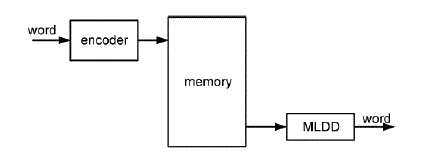 |
| The results for the exhaustive checks are shown in Table II. These results prove the hypothesis for the codes with smaller word size (N=15 and N=63). For N=255 up to three errors have been exhaustively tested while for N=1023 only single and double error combinations have been exhaustively tested. |
| To complement the results of the exhaustive checks for larger codes and number of errors, simulations using random error patterns have been used. In all the experiments, one billion error combinations are tested. The results for errors affecting more than four bits are shown in Table III, since for errors affecting up to four bits there were no undetected errors. It can be observed that for errors affecting more than four bits there is a small number of error combinations that will not be detected in the first three iterations. This number decreases with word size and also with the number of errors. The decrease with the word size can be explained as follows, the larger the word size, the larger the number of MLD check equations in Table I and therefore it is more unlikely that errors occur in the same equation. As for the number of errors, a similar reasoning applies: the more errors occur, the larger the probability that an odd number of errors occurs in at least one equation. Finally it must be noted that the probabilities of undetected errors are different for an even and an odd number of errors as in the latter case, one of the errors must occur in a bit which is not checked by any equation. |
| The simulation results presented suggest that all errors affecting three and four bits would be detected in the first three iterations. For errors affecting a larger number of bits, there is a small probability of not being detected in those iterations. For large word sizes, the probabilities are sufficiently small to be acceptable in many applications. |
| In summary, the first three iterations will detect all errors affecting four or fewer bits, and almost every other detectable error affecting more bits. This is a slightly worse performance than in the case of DS-LDPC codes where errors affecting five bits were additionally always detected. However, the majority logic circuitry is simpler for EG-LDPC codes, as the number of equations is a power of two and an approach based on sorting networks proposed in can be used to reduce the cost of the majority logic voting. |
| In addition, EG-LDPC codes have block lengths close to a power of two, thus fitting well to the requirements of modern memory systems. This may mean that in some cases it may be more convenient to use an EG-LDPC code and keep a word size compatible with existing designs (power of two) than using a DS-LDPC code requiring a different word size or a shortened version of that code. When using word size which is a power of two, there would be a bit which is not used by the EG-LDPC code (see Table I). This bit can be used for a parity covering all bits in the word that would detect all errors affecting an odd number of bits. In that case, the design using the EG-LDPC would also detect all errors affecting five or fewer bits. |
D.Need For Error Detection
|
| Environmental interference and physical defects in the communication medium can cause random bit errors during data transmission. Error coding is a method of detecting and correcting these errors to ensure information is transferred intact from its source to its destination. Error coding is used for fault tolerant computing in computer memory, magnetic and optical data storage media, satellite and deep space communications, network communications, cellular telephone networks, and almost any other form of digital data communication. Error coding uses mathematical formulas to encode data bits at the source into longer bit words for transmission. |
| The “code word" can then be decoded at the destination to retrieve the information. The extra bits in the code word provide redundancy that, according to the coding scheme used, will allow the destination to use the decoding process to determine if the communication medium introduced errors and in some cases correct them so that the data need not be retransmitted. Different error coding schemes are chosen depending on the types of errors expected, the communication medium's expected error rate, and whether or not data retransmission is possible. |
| Faster processors and better communications technology make more complex coding schemes, with better error detecting and correcting capabilities, possible for smaller embedded systems, allowing for more robust communications. However, tradeoffs between bandwidth and coding overhead, coding complexity and allowable coding delay between transmissions, must be considered for each application. |
E.Error Detecting Codes
|
| Here we will only consider binary messages and so the transmitted messages consist of strings of 0’s and 1’s. The essential idea of forward error control coding is to augment these message bits with deliberately introduced redundancy in the form of extra check bits to produce a codeword for the message. These check bits are added in such a way that code words are sufficiently distinct from one another that the transmitted message can be correctly inferred at the receiver, even when some bits in the codeword are corrupted during transmission over the channel. The simplest possible coding scheme is the single parity check code (SPC).The SPC involves the addition of a single extra bit to the binary message, the value of which depends on the bits in the message. In an even parity code, the additional bit added to each message ensures an even number of 1s in every codeword. |
One Dimensional Parity Check
|
| The most common and least expensive mechanism for error- detection is the simple parity check. In this technique, a redundant bit called parity bit, is appended to every data unit so that the number of 1’s in the unit (including the parity becomes even). Blocks of data from the source are subjected to a check bit or Parity bit generator form, where a parity of 1 is added to the block if it contains an odd number of 1’s (ON bits) and 0 is added if it contains an even number of 1’s. At the receiving end the parity bit is computed from the received data bits and compared with the received parity bit, as shown in Fig. 3.9. This scheme makes the total number of 1’s even, that is why it is called even parity checking. |
Parity Check Code
|
| Note that for the sake of simplicity, we are discussing here the even-parity checking, where the number of 1’s should be an even number. It is also possible to use odd-parity checking, where the number of 1’s should be odd. |
Two Dimensional Parity Check
|
| Performance can be improved by using two-dimensional parity check, which organizes the block of bits in the form of a table. Parity check bits are calculated for each row, which is equivalent to a simple parity check bit. Parity check bits are also calculated for all columns then both are sent along with the data. At the receiving end these are compared with the parity bits calculated on the received data. |
| Two Dimensional Parity Checking increases the likelihood of detecting burst errors. As we have shown above that a 2-D Parity check of n bits can detect a burst error of n bits. A burst error of more than n bits is also detected by 2-D Parity check with a high-probability. There is, however, one pattern of error that remains elusive. If two bits in one data unit are damaged and two bits in exactly same position in another data unit are also damaged, the 2-D Parity check checker will not detect an error. For example, if two data units: 11001100 and 10101100. If first and second from last bits in each of them is changed, making the data units as 01001110 and 00101110, the error cannot be detected by 2-D Parity check. |
F. Low Density Parity Check Codes
|
| LDPC codes are block codes with parity-check matrices that contain only a very small number of non-zero entries. In which guarantees both a decoding complexity which increases only linearly with the code length and a minimum distance which also increases linearly with the code length. |
| LDPC code itself is no different to any other block code. Indeed existing block codes can be successfully used with the LDPC iterative decoding algorithms if they can be represented by a sparse parity-check matrix. Generally, however, finding a sparse parity-check matrix for an existing code is not practical. Instead LDPC codes are designed by constructing a sparse parity-check matrix first and then determining a generator matrix for the code afterwards. The biggest difference between LDPC codes and classical block codes is how they are decoded. Classical block codes are generally decoded with ML like decoding algorithms and so are usually short and designed algebraically to make this task less complex. LDPC codes however are decoded iteratively using a graphical representation of their parity-check matrix. |
RESULTS AND DISCUSSIONS
|
A.Simulation Result of Encoder
|
| Fig 5.1 shows the simulation result of an Encoder. The data input to given to the memory is encoded first through this encoder block. The input to the encoder is the 7 bit information and output is the 15 bit information. The signal output is form s1 to s8. |
B.Simulation Result of Memory
|
| Fig 5.2 shows the simulation result of the memory. The data in and data out of the memory is the 15 bit information taken from the encoder. The temporary RAM is used as memory element. The clock event is used to read from the memory and write data to the memory. The memory address of the particular data is also specified. |
C.Simulation Result of Majority Logic Decoder With Control
|
| Fig 4.3 shows the Majority logic decoder with control. The control input is x which is the 15 bit information and the control clock given. The control output is y which is also the 15 bit information. The row density is calculated from 1 to 4. The Majority gate output is obtained by Ex-Or operation. The data output with error and without error are calculated. |
D.Simulation Result of Serial Majority Logic Decoder
|
| Fig 5.4 shows the output of the Serial Majority logic decoder. In this decoder the data read from the memory is given as serial input to the decoder. The data is verified whether it is with error or without error by serial cyclic shifting. This method is called One Step Majority Logic Decoding. |
CONCLUSION
|
| The detection of errors during the first iterations of serial one step Majority Logic Decoding of EG-LDPC codes has been studied. The objective was to reduce the decoding time by stopping the decoding process when no errors are detected. The simulation results show that all tested combinations of errors affecting up to four bits are detected in the first three iterations of decoding. These results extend the ones recently presented for DS-LDPC codes, making the modified one step majority logic decoding more attractive for memory applications. The designer now has a larger choice of word lengths and error correction capabilities. |
Figures at a glance
|
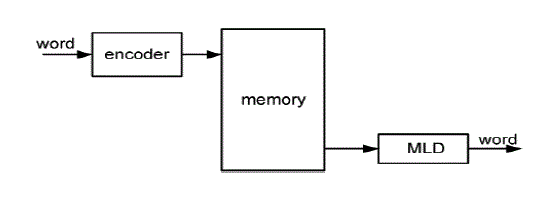 |
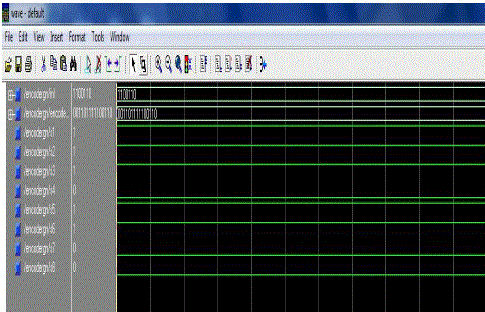 |
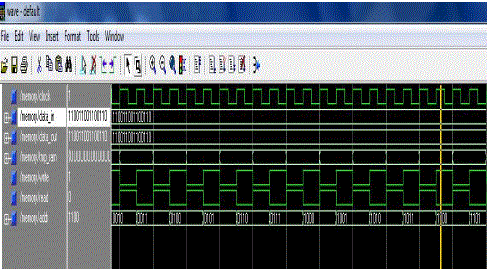 |
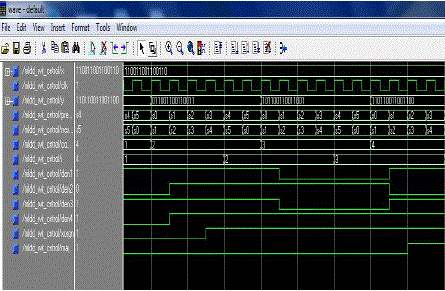 |
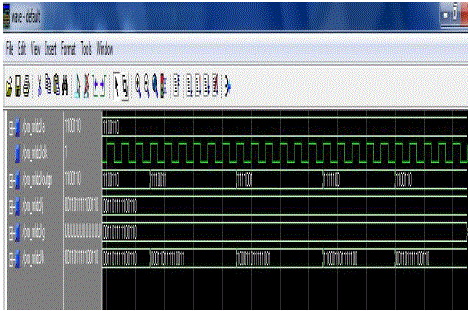 |
| Figure 1 |
Figure 2 |
Figure 3 |
Figure 4 |
Figure 5 |
|
| |
References
|
- Pedro Reviriego, Juan A. Maestro, and Mark F. Flanagan, (Jan 2013)“Error Detection in Majority Logic Decoding of Euclidean Geometry Low DensityParity Check (EG-LDPC) Codes,” IEEE Trans. Very Large Scale Integr.(VLSI) Syst.. vol. 21, no. 1,
- Liu.S, P. Reviriego, and J. Maestro, (Jan. 2012) “Efficient majority logic fault detection with difference-set codes for memory applications,” IEEE Trans. Very Large Scale Integr. (VLSI) Syst., vol. 20, no. 1, pp. 148–156,.
- Naeimi.H and A. DeHon, (Apr. 2009) “Fault secure encoder and decoder for nanomemory applications,” IEEE Trans. Very Large Scale Integr. (VLSI) Syst., vol. 17, no. 4, pp. 473–486,.
- Naseer.R and J. Draper, (2008) “DEC ECC design to improve memory reliability in sub- 100 nm technologies,” Proc. IEEE ICECS, pp. 586–589,
- Vasic.B and S. K. Chilappagari, (Nov. 2007) “An information theoretical framework for analysis and design of nanoscale fault-tolerant memories based on low-density parity-check codes,” IEEE Trans. Circuits Syst. I, Reg. Papers, vol. 54, no. 11, pp. 2438–2446,.
- Naeimi.H and A. DeHon, (2007) “Fault secure encoder and decoder for Memory applications,” in Proc. IEEE Int. Symp. Defect Fault Toler. VLSI Syst., , pp. 409–417.
- Bajura M.A, Y. Boulghassoul, R. Naseer, S. DasGupta, A. F.Witulski, J. Sondeen, S. D. Stansberry, J. Draper, L. W. Massengill, and J. N. Damoulakis, (Aug. 2007) “Models and algorithmic limits for an ECC-based approach to hardening sub-100-nm SRAMs,” IEEE Trans. Nucl. Sci., vol. 54, no. 4, pp. 935–945,.
- Ghosh.S and P. D. Lincoln, (2007). “Dynamic low-density parity check codes for fault-tolerant nano-scale memory,” presented at the Foundations Nanosci. (FNANO), Snowbird, Utah,
- Ghosh.S and P. D. Lincoln,( 2007) “Low-density parity check codes for error correction in nanoscale memory,” SRI Computer Science Lab., Menlo Park, CA, Tech. Rep. CSL-0703.
|